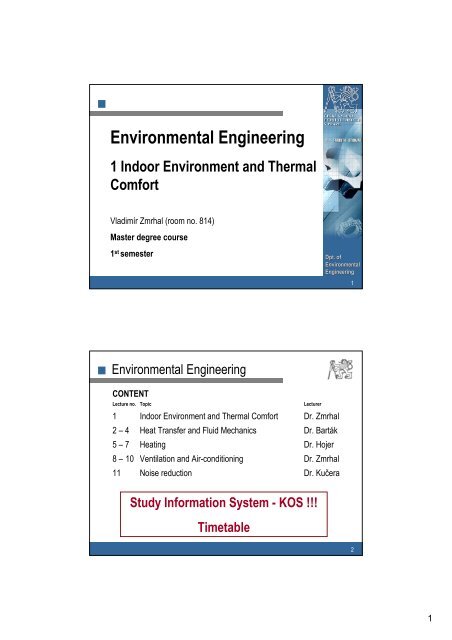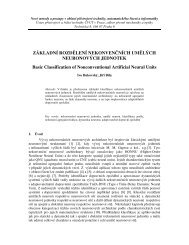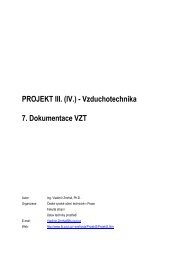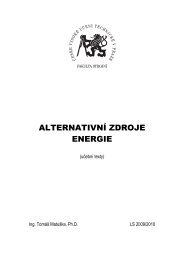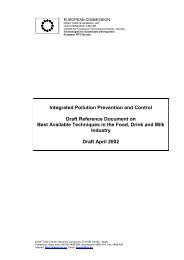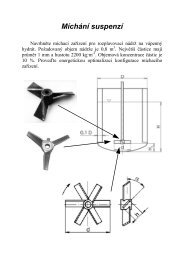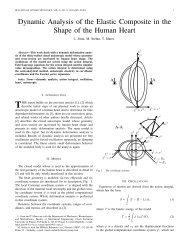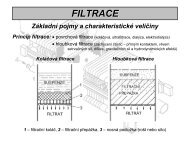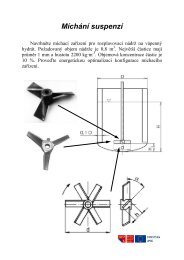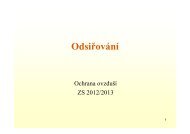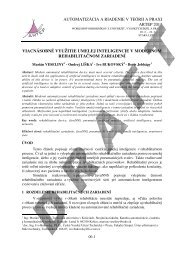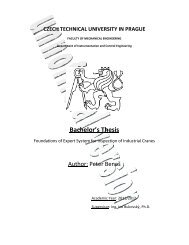Indoor Environment and Thermal Comfort
Indoor Environment and Thermal Comfort
Indoor Environment and Thermal Comfort
Create successful ePaper yourself
Turn your PDF publications into a flip-book with our unique Google optimized e-Paper software.
<strong>Environment</strong>al Engineering<br />
1 <strong>Indoor</strong> <strong>Environment</strong> <strong>and</strong> <strong>Thermal</strong><br />
<strong>Comfort</strong><br />
Vladimír Zmrhal (room no. 814)<br />
Master degree course<br />
1 st semester<br />
Dpt<br />
Dpt. of<br />
<strong>Environment</strong>al<br />
Engineering<br />
1<br />
<strong>Environment</strong>al Engineering<br />
CONTENT<br />
Lecture no. Topic Lecturer<br />
1 <strong>Indoor</strong> <strong>Environment</strong> <strong>and</strong> <strong>Thermal</strong> <strong>Comfort</strong> Dr. Zmrhal<br />
2 – 4 Heat Transfer <strong>and</strong> Fluid Mechanics Dr. Barták<br />
5 – 7 Heating Dr. Hojer<br />
8 – 10 Ventilation <strong>and</strong> Air-conditioning Dr. Zmrhal<br />
11 Noise reduction Dr. Kučera<br />
Study Information System - KOS !!!<br />
Timetable<br />
2<br />
1
<strong>Environment</strong>al Engineering<br />
EXAM<br />
Exchange Students (Erasmus)<br />
4 tests (minimum 50 points from 100)<br />
Students of Master Study Programme Mechanical Engineering<br />
(Field of study: <strong>Environment</strong>al Engineering)<br />
4 test (minimum 50 points from 100)<br />
oral examination<br />
State Final Exam !!!<br />
(January)<br />
3<br />
<strong>Environment</strong>al Engineering<br />
TESTS<br />
Week no. Topic<br />
5 Heat Transfer <strong>and</strong> Fluid Mechanics<br />
8 Heating<br />
11 Ventilation <strong>and</strong> Air-conditioning<br />
12 Noise <strong>and</strong> Vibration, <strong>Indoor</strong> <strong>Environment</strong> <strong>and</strong> <strong>Thermal</strong> <strong>Comfort</strong><br />
13 Resit<br />
http://www.users.fs.cvut.cz/~zmrhavla/EE/EE.htm<br />
4<br />
2
<strong>Environment</strong>al Engineering<br />
LITERATURE<br />
ASHRAE H<strong>and</strong>book<br />
2008 HVAC Systems <strong>and</strong> Equipment<br />
2009 Fundamentals<br />
2010 Refrigeration<br />
2011 HVAC Application<br />
5<br />
<strong>Indoor</strong> <strong>Environment</strong><br />
Factors of <strong>Indoor</strong> <strong>Environment</strong><br />
<strong>Thermal</strong> environment<br />
<strong>Indoor</strong> contaminants (CO 2 , combustion products, VOC, tobacco<br />
smoke, …)<br />
Outdoor pollutants<br />
Odours<br />
Acoustic environment<br />
Lightning<br />
Ionizing radiation<br />
Electromagnetic waves<br />
…<br />
IAQ – <strong>Indoor</strong> Air Quality<br />
6<br />
3
Physiology<br />
Heat Production<br />
Q = Q −W : A<br />
m<br />
Q Qm<br />
W<br />
= −<br />
A A A<br />
D D D<br />
m<br />
D<br />
[W]<br />
[W/m 2 ]<br />
q = q − w<br />
[W/m 2 ]<br />
q m<br />
w<br />
…total metabolic rate<br />
…external mechanical work<br />
A D …body surface area [m 2 ]<br />
7<br />
Physiology<br />
DuBois surface area<br />
A = 0.202m h<br />
D<br />
0.425 0.725<br />
[m 2 ]<br />
f<br />
cl<br />
A<br />
A<br />
= cl<br />
D<br />
… clothing area factor - correction factor for<br />
clothed body<br />
A cl … area of clothed body [m 2 ]<br />
A D = 1.8 m 2<br />
… for man 70 kg <strong>and</strong> 1.73 m<br />
f cl = 1.1 ÷ 1.83<br />
8<br />
4
Physiology<br />
Human Thermoregulation<br />
metabolic activities of the body result almost completely in heat that<br />
must be continuously dissipated <strong>and</strong> regulated to maintain normal<br />
body temperature<br />
internal temperature rise with the activity ∼ 37 °C<br />
temperature regulatory centre in the brain (hypothalamus)<br />
(36.8 °C at rest of comfort; 37.4 when walking)<br />
skin temperature 33 to 34 °C<br />
resting adults produces about 100 W of heat<br />
9<br />
Energy Balance<br />
Figure on the board<br />
q = qm − w = ± qc ± qr + qev ± qres ± q<br />
{<br />
con [W/m 2 ]<br />
0<br />
10<br />
5
Energy Balance<br />
Total metabolic rate<br />
m<br />
External mechanical work<br />
w = η ⋅q m<br />
[W/m 2 ]<br />
η<br />
…mechanical efficiency η = 0 …for most activities<br />
η max = 0.2 …bicycle ergometer<br />
11<br />
Energy Balance<br />
Metabolic heat generation<br />
Activity<br />
Sleeping<br />
Reading, seated<br />
Filing, seated<br />
Walking 2 km/h<br />
Dancing<br />
q … 1 met 2 q m<br />
[W/m 2 ] [met]<br />
46 0.8<br />
58<br />
1<br />
70 1.2<br />
110 1.9<br />
140 to 255 2.4 to 4.4<br />
= 58.1 W/m<br />
12<br />
6
Energy Balance<br />
Heat transfer by convection<br />
( )<br />
q = h f t − t [W/m 2 ]<br />
c c cl cl a<br />
Convective heat transfer coefficient h c [W/m 2 K]<br />
h = 2.38( t − t ) 0.25<br />
c cl a<br />
… free convection<br />
hc<br />
= 12.1<br />
w<br />
… forced convection<br />
13<br />
Energy Balance<br />
Heat exchange by radiation<br />
( )<br />
q = h f t − t [W/m 2 ]<br />
r r cl cl r<br />
Radiant heat transfer coefficient h r [W/m 2 K]<br />
h<br />
r<br />
A T −T<br />
= εσ<br />
A t − t<br />
4 4<br />
r cl r<br />
D cl r<br />
≈ 4.7ε<br />
[W/m 2 K]<br />
ε …emissivity of the clothing, usually 0.95 [-]<br />
σ …Stefan-Boltzmann constant 5.6710 -8 [W/m 2 K 4 ]<br />
A r …effective radiation area of the body [m 2 ], A r /A D ≈ 0.7<br />
14<br />
7
Energy Balance<br />
Conduction through clothing<br />
1<br />
qr + qc = ( tsk − tcl<br />
)<br />
[W/m 2 ]<br />
R<br />
cl<br />
R<br />
cl<br />
⎛ s ⎞ ⎛ s ⎞<br />
= ∑⎜ ⎟ + ∑⎜ ⎟<br />
⎝ λ ⎠ ⎝ λ ⎠<br />
cl<br />
air<br />
[W/m 2 K]<br />
Rcl<br />
= 0.155⋅ I<br />
… 1 clo = 0.155 m 2 K/W<br />
15<br />
Energy Balance<br />
Clothing insulation<br />
Clothing ensembles<br />
Trousers, long-sleeved shirt, longsleeved<br />
sweater, T-shirt<br />
Walking shorts, short-sleeved shirt<br />
R [m 2 K/W]<br />
0.155<br />
0.055<br />
I [clo]<br />
1<br />
0.36<br />
…<br />
…<br />
…<br />
16<br />
8
Energy Balance<br />
Respiration heat loss<br />
q<br />
res<br />
( − h )<br />
M hex<br />
=<br />
A<br />
D<br />
in<br />
[W/m 2 ]<br />
M<br />
h ex<br />
h in<br />
…pulmonary ventilation rate [kg/s]<br />
…enthalpy of exhaled air [J/kg]<br />
…ethalpy of inspired (ambient) air [J/kg]<br />
−<br />
M = ⋅ 6 ⋅q ⋅ A<br />
1.43 10<br />
m D<br />
[kg/s]<br />
17<br />
Energy Balance<br />
t = 32.6 + 0.066⋅ t + 32⋅<br />
x<br />
ex in in<br />
ϕ = 100<br />
ex<br />
[°C]<br />
[%]<br />
or<br />
x = 0.0277 + 0.000065 ⋅ t + 0.2⋅ x<br />
[kg w.v. /kg d.a. ]<br />
t in<br />
ex in in<br />
… temperature of inspired (ambient) air [°C]<br />
x in … humidity ratio [kg w.v. /kg d.a. ]<br />
18<br />
9
Energy Balance<br />
Evaporative heat loss from the skin<br />
q = q + q<br />
ev ev , dif ev , rsw<br />
[W/m 2 ]<br />
natural diffusion of water through the skin<br />
( )<br />
q = ⋅ ⋅t − − p<br />
−3<br />
ev , dif<br />
3.05 10 256<br />
sk<br />
3373<br />
v<br />
p v<br />
t sk<br />
… water vapor pressure in ambient air [Pa]<br />
… temperature of skin [°C]<br />
19<br />
Energy Balance<br />
heat loss by evaporation of sweat secretion<br />
A<br />
q = h p − p<br />
"<br />
( )<br />
ev<br />
ev , rsw ev v , sk v<br />
AD<br />
h ev … evaporative heat transfer coefficient [W/m 2 K]<br />
A ev … effective evaporative area of the body [m 2 ]<br />
p“ v,sk … saturated water vapor pressure at skin temperature [Pa]<br />
h<br />
ev<br />
16.7hc<br />
=<br />
⎡ ⎛ 1 ⎞<br />
1+ 2.22h ⎢R − ⎜1− ⎟ h + h<br />
⎣ ⎝ fcl<br />
⎠<br />
( )<br />
c cl c r<br />
⎤<br />
⎥<br />
⎦<br />
20<br />
10
Parameters Influenced <strong>Thermal</strong> <strong>Comfort</strong><br />
<strong>Indoor</strong> <strong>Environment</strong> Parametres<br />
air temperature t a [°C]<br />
relative humidity (RH) ϕ [%]<br />
mean radiant temperature (MRT) t r [°C]<br />
air velocity w a [m/s]<br />
turbulence intensity Tu [-]<br />
Personal Parameters<br />
metabolism q m <strong>and</strong> work w<br />
thermal insulation of the clothing<br />
<strong>and</strong> also age, sex (male/female), …<br />
21<br />
<strong>Thermal</strong> <strong>Comfort</strong><br />
condition of mind that expresses satisfaction with the thermal<br />
environment<br />
effect on health <strong>and</strong> performance<br />
Prediction of <strong>Thermal</strong> <strong>Comfort</strong><br />
Rohles <strong>and</strong> Nevins (1971) indicate values that provides thermal<br />
comfort (optimum)<br />
required temperature of skin<br />
t<br />
,<br />
= 35.7 − 0.0275( q − w )<br />
sk req<br />
required evaporative heat loss<br />
m<br />
( )<br />
qev , rsw , req<br />
= 0.42 qm<br />
− w − 58.15<br />
22<br />
11
<strong>Thermal</strong> <strong>Comfort</strong><br />
<strong>Thermal</strong> comfort equation (TCE)<br />
( ) ( )<br />
q − w = h f t − t + h f t − t +<br />
m c cl cl a r cl cl r<br />
q c<br />
( ⎡<br />
( qm<br />
w ) ⎤ pa<br />
)<br />
−3<br />
+ 3.06⋅10 256 35.7 − 0.0275 − − − 3373 +<br />
⎣<br />
t sk,req<br />
⎦<br />
q ev,dif<br />
−6<br />
( q w ) q ( h h )<br />
+ 0.42 − − 58.15 + 1.43⋅10<br />
−<br />
m m ex in<br />
q res<br />
23<br />
q r<br />
q ev,rsw,req<br />
<strong>Thermal</strong> <strong>Comfort</strong><br />
where t cl calculates from the heat flow through clothing<br />
1<br />
qc + qr = ( tsk − tcl<br />
)<br />
Rcl<br />
1<br />
hcfcl ( tcl − ta ) + hrfcl ( tcl − tr ) = ⎡ 35.7 0.0275 ( qm w ) tcl<br />
R<br />
⎣ − − − ⎤⎦<br />
cl<br />
q c q r<br />
t sk,req<br />
tcl = 35.7 − 0.0275( qm − w ) − Rcl ⎡⎣<br />
hcfcl ( tcl − ta ) + hrfcl ( tcl − tr<br />
) ⎤⎦<br />
iteration<br />
24<br />
12
<strong>Thermal</strong> <strong>Comfort</strong><br />
Example: Heat flow through clothing<br />
???<br />
25<br />
<strong>Thermal</strong> <strong>Comfort</strong><br />
ASHRAE <strong>Thermal</strong> Sensation Scale<br />
+3 hot<br />
+2 warm<br />
+1 slightly warm<br />
0 neutral<br />
-1 slightly cool<br />
-2 cool<br />
-3 cold<br />
<strong>Thermal</strong> Sensation<br />
=<br />
Predicted Mean Vote<br />
(PMV)<br />
26<br />
13
<strong>Thermal</strong> <strong>Comfort</strong><br />
Fanger‘s Model of <strong>Thermal</strong> <strong>Comfort</strong> (St<strong>and</strong>ard Model)<br />
thermal load on the body<br />
L = actual heat flow from the body – heat loss to the<br />
actual environment for a person hypothetically kept at<br />
comfort values of t sk <strong>and</strong> q ev,rsw at the actual activity level<br />
respectively<br />
L = left side of theTCE – right side of the TCE<br />
27<br />
<strong>Thermal</strong> <strong>Comfort</strong><br />
Predicted Mean Vote – PMV index<br />
PMV predicts the mean response of a large group of people<br />
according to thermal sensation scale<br />
−0.036q ( 0.303<br />
m<br />
0.028)<br />
PMV = e + L<br />
Predicted Percent of Dissatisfied – PPD index<br />
PPD = − ⎡<br />
⎣− PMV + PMV<br />
4 2<br />
100 95exp (0.03353 0.2179 )<br />
⎤<br />
⎦<br />
28<br />
14
<strong>Thermal</strong> <strong>Comfort</strong><br />
PMV = 0 → about 5 % of the people will be dissatisfied<br />
29<br />
<strong>Thermal</strong> <strong>Comfort</strong><br />
Category of global<br />
thermal comfort<br />
A<br />
B<br />
C<br />
PPD [%]<br />
<strong>Thermal</strong> <strong>Comfort</strong><br />
Operative temperature<br />
( ) ( )<br />
q + q = h + h f t − t<br />
c r c r cl cl o<br />
h = h + h<br />
c<br />
r<br />
( − ) + ( − ) = ( + )( − )<br />
h t t h t t h h t t<br />
c cl a r cl r c r cl o<br />
t<br />
o<br />
h t<br />
=<br />
h<br />
c a<br />
c<br />
+ h t<br />
+ h<br />
r r<br />
r<br />
[°C]<br />
31<br />
<strong>Thermal</strong> <strong>Comfort</strong><br />
=<br />
c<br />
hc<br />
+<br />
r<br />
A h h<br />
= + ( 1−<br />
)<br />
t At A t<br />
o a r<br />
w [m/s]<br />
A [-]<br />
<strong>Thermal</strong> <strong>Comfort</strong><br />
Operative temperature necessary for comfort (PMV = 0) of person<br />
in summer clothing at RH = 50 %<br />
33<br />
<strong>Thermal</strong> <strong>Comfort</strong><br />
Mean radiant Temperature<br />
the uniform temperature of an imaginary enclosure in which radiant<br />
heat transfer from the human equals the radiant heat transfer in the<br />
actual nonuniform enclosure<br />
t F T F T F T<br />
4<br />
4 4 4<br />
r<br />
=<br />
p−1 1<br />
+<br />
p−2 2<br />
+ ... +<br />
p−n n<br />
− 273.15<br />
[°C]<br />
F p-n<br />
T n<br />
…angle factor between a person <strong>and</strong> surface n<br />
…surface temperature of the surface [K]<br />
34<br />
17
<strong>Thermal</strong> <strong>Comfort</strong><br />
35<br />
<strong>Thermal</strong> <strong>Comfort</strong><br />
Simplification - elementary case (rectangle vs. point)<br />
Eckert<br />
F<br />
1−2<br />
1 1 c a + b + c<br />
= − arctg<br />
8 4π<br />
ab<br />
2 2 2<br />
In the room:<br />
∑F1 − 2<br />
= 1<br />
36<br />
18
<strong>Thermal</strong> <strong>Comfort</strong><br />
Angle factor algebra<br />
[°C]<br />
F = F + F + F + F<br />
B−A B−11 B−12 B−21 B−22<br />
F = F − F<br />
B−A B−11 B−12<br />
( )<br />
F = F − F + F + F<br />
B−A B−11 B−12 B−21 B−22<br />
37<br />
<strong>Thermal</strong> <strong>Comfort</strong><br />
Example: Calculation of MRT <strong>and</strong> t o<br />
Room: L = 6 m, W = 4 m, H = 2.7 m<br />
t a = 28 °C<br />
t w = t a<br />
t ceiling = 18 °C<br />
w = 0.15 m/s<br />
Calculate MRT <strong>and</strong> t o in the middle of the room at hight h = 1.5 m.<br />
MRT = ?<br />
t o = ? 2 2 2<br />
F<br />
1−2<br />
1 1 c a + b + c<br />
= − arctg<br />
8 4π<br />
ab<br />
38<br />
19
Local Discomfort<br />
<strong>Thermal</strong> non-uniform conditions<br />
radiant temperature asymmetry<br />
draft<br />
vertical air temperature difference<br />
warm or cold floors<br />
Source: <strong>Thermal</strong> comfort. The booklet. INNOVA 2002. <br />
39<br />
Local Discomfort<br />
Radiant temperature asymmetry<br />
the difference between the<br />
plane radiant temperature of<br />
the opposite sides of a small<br />
plane element<br />
∆ t = t − t<br />
pr pr 1 pr 2<br />
40<br />
20
Local Discomfort<br />
Radiant temperature asymmetry ∆t pr [°C]<br />
Category of thermal comfort<br />
A,B<br />
Warm ceiling<br />
Local Discomfort<br />
Draft Rate<br />
DR = − t w − w ⋅ Tu +<br />
0.62<br />
(34<br />
a<br />
)(<br />
a<br />
0.05) (0.37<br />
a<br />
3.14)<br />
Source: <strong>Thermal</strong> comfort. The booklet. INNOVA 2002. <br />
43<br />
Local Discomfort<br />
Vertical air temperature difference<br />
100<br />
PD =<br />
1 + exp 5.67 − 0.856 ∆ta<br />
, v<br />
( )<br />
Source: <strong>Thermal</strong> comfort. The booklet. INNOVA 2002. <br />
44<br />
22
Local Discomfort<br />
Warm or cold floors<br />
Category<br />
of thermal<br />
comfort<br />
A,B<br />
C<br />
Percentage<br />
of<br />
dissatisfied<br />
PD [%]<br />
Adaptive Model of <strong>Thermal</strong> <strong>Comfort</strong><br />
Adaptation – people can acclimatize themselves<br />
changing posture <strong>and</strong> activity<br />
clothing changing<br />
leaving the space / move<br />
opening a window, shading …<br />
For buildings without mechanical cooling (air-conditioning) or with lowenergy<br />
cooling systems (night ventilation, …)<br />
47<br />
Thank you for your<br />
attention<br />
48<br />
24


